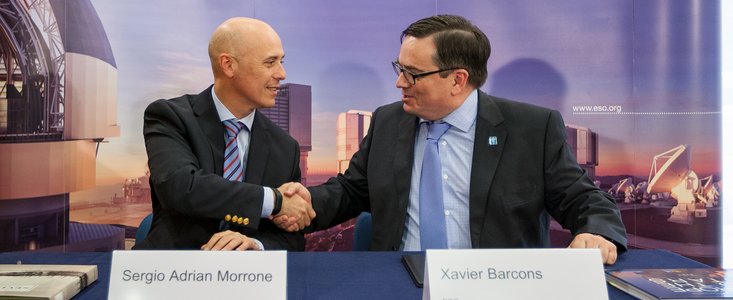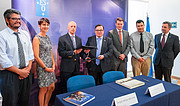Annuncio
L’ESO firma un contratto con un’azienda cilena per la struttura tecnica dell’ELT
12 Marzo 2018
L’ESO ha firmato un contratto con l’azienda di ingegneria e costruzioni Abengoa Chile per costruire la struttura tecnica dell’ELT presso l’Osservatorio Paranal dell’ESO nel nord del Cile. Questa nuova struttura ospiterà i centri per l’assemblaggio e la manutenzione degli specchi dell’ELT (Extremely Large Telescope) dell’ESO, ma anche le installazioni per il rivestimento, la pulitura e lo smontaggio, che servono per rivestire e mantenere la riflettività degli specchi.
Lo specchio primario dell’ELT sarà formato da 798 segmenti riflettenti separati [1]. Presso la struttura tecnica dell’ELT, i segmenti puliti e assemblati saranno rivestiti e integrati ai sensori di bordo al lato di ciascuno di essi, in modo da rilevarne la posizione in rapporto ai suoi vicini [2].
Nel momento in cui il telescopio sarà completo e in funzione, ogni segmento dello specchio primario dovrà essere rivestito ogni anno e mezzo, per mantenerne la pulizia e la riflettività. Dato che ci sono 798 segmenti, il modo più efficace per farlo è rimuovere, pulire, rivestire e riposizionare due o tre segmenti al giorno.
La struttura tecnica dell’ELT ospiterà anche l’unità di rivestimento degli specchi secondario e terziario dell’ELT, ognuno dei quali misura circa quattro metri di diametro.
La struttura sarà anche usata per l’assemblaggio iniziale, l’integrazione e la verifica degli specchi, così come per le future attività di rivestimento.
Dopo circa tre mesi di progettazione accurata, la costruzione dell’edificio inizierà nella seconda metà del 2018 e durerà 11 mesi. Dovrebbe essere completata entro luglio 2019.
La cerimonia della firma si è tenuta presso gli uffici dell’ESO a Vitacura, Santiago, Cile, e il contratto è stato firmato da Sergio Adrian Morrone di Abengoa Chile e dal Direttore Generale dell’ESO, Xavier Barcons, in presenza di Willy Benz, Presidente del Consiglio dell’ESO, e dell’Ambasciatore Gabriel Rodríguez, Direttore dell’Energia, Scienza, Tecnologia e Innovazione presso il Ministero cileno degli Affari Esteri. Hanno anche partecipato il rappresentante dell’ESO in Cile, Fernando Comerón, e altri funzionari dell’ESO e di Abengoa.
Note
[1] Lo specchio primario dell’ELT misurerà 39 metri di diametro e sarà formato da 798 segmenti. Questi hanno forma esagonale, in modo da permettere l’uso di una struttura di supporto comune a tutti. La dimensione massima angolo ad angolo dei segmenti è di circa 1,45 metri. Ogni segmento sarà in grado di muoversi individualmente, formando un sistema ottico attivo che assicurerà un’ottima qualità di immagini in qualsiasi momento.
[2] Questi sensori sono i più precisi mai utilizzati in un telescopio e possono misurare le posizioni relative con un’accuratezza di pochi nanometri. Sono una parte fondamentale del complesso sistema che rileverà di continuo la posizione dei segmenti dello specchio primario dell’ELT in rapporto ai vicini, permettendo ai segmenti di lavorare insieme per formare un perfetto sistema di immagini.
Ulteriori informazioni
L'ESO (European Southern Observatory, o Osservatorio Australe Europeo) è la principale organizzazione intergovernativa di Astronomia in Europa e l'osservatorio astronomico più produttivo al mondo. È sostenuto da 16 paesi: Austria, Belgio, Brasile, Danimarca, Finlandia, Francia, Germania, Italia, Paesi Bassi, Polonia, Portogallo, Regno Unito, Repubblica Ceca, Spagna, Svezia, e Svizzera, oltre al paese che ospita l'ESO, il Cile e dall’Australia come partner strategico. L'ESO svolge un ambizioso programma che si concentra sulla progettazione, costruzione e gestione di potenti strumenti astronomici da terra che consentano agli astronomi di realizzare importanti scoperte scientifiche. L'ESO ha anche un ruolo di punta nel promuovere e organizzare la cooperazione nella ricerca astronomica. L'ESO gestisce tre siti osservativi unici al mondo in Cile: La Silla, Paranal e Chajnantor. Sul Paranal, l'ESO gestisce il Very Large Telescope e il suo Interferometro di punta a livello mondiale, ma anche due telescopi per survey: VISTA, che, lavora nella banda infrarossa, e il VST (VLT Survey Telescope) in luce visibile. L'ESO è il partner principale di due strumentazioni sul Chajnantor, APEX e ALMA, il più grande progetto astronomico esistente. E sul Cerro Armazones, vicino al Paranal, l'ESO sta costruendo l'Extremely Large Telescope o ELT (significa Telescopio Europeo Estremamente Grande), un telescopio da 39 metri che diventerà "il più grande occhio del mondo rivolto al cielo".
Links
A proposito dell'annuncio
| Identificazione: | ann18014 |
Our use of Cookies
We use cookies that are essential for accessing our websites and using our services. We also use cookies to analyse, measure and improve our websites’ performance, to enable content sharing via social media and to display media content hosted on third-party platforms.
ESO Cookies Policy
The European Organisation for Astronomical Research in the Southern Hemisphere (ESO) is the pre-eminent intergovernmental science and technology organisation in astronomy. It carries out an ambitious programme focused on the design, construction and operation of powerful ground-based observing facilities for astronomy.
This Cookies Policy is intended to provide clarity by outlining the cookies used on the ESO public websites, their functions, the options you have for controlling them, and the ways you can contact us for additional details.
What are cookies?
Cookies are small pieces of data stored on your device by websites you visit. They serve various purposes, such as remembering login credentials and preferences and enhance your browsing experience.
Categories of cookies we use
Essential cookies (always active): These cookies are strictly necessary for the proper functioning of our website. Without these cookies, the website cannot operate correctly, and certain services, such as logging in or accessing secure areas, may not be available; because they are essential for the website’s operation, they cannot be disabled.
Functional Cookies: These cookies enhance your browsing experience by enabling additional features and personalization, such as remembering your preferences and settings. While not strictly necessary for the website to function, they improve usability and convenience; these cookies are only placed if you provide your consent.
Analytics cookies: These cookies collect information about how visitors interact with our website, such as which pages are visited most often and how users navigate the site. This data helps us improve website performance, optimize content, and enhance the user experience; these cookies are only placed if you provide your consent. We use the following analytics cookies.
Matomo Cookies:
This website uses Matomo (formerly Piwik), an open source software which enables the statistical analysis of website visits. Matomo uses cookies (text files) which are saved on your computer and which allow us to analyze how you use our website. The website user information generated by the cookies will only be saved on the servers of our IT Department. We use this information to analyze www.eso.org visits and to prepare reports on website activities. These data will not be disclosed to third parties.
On behalf of ESO, Matomo will use this information for the purpose of evaluating your use of the website, compiling reports on website activity and providing other services relating to website activity and internet usage.
Matomo cookies settings:
Additional Third-party cookies on ESO websites: some of our pages display content from external providers, e.g. YouTube.
Such third-party services are outside of ESO control and may, at any time, change their terms of service, use of cookies, etc.
YouTube: Some videos on the ESO website are embedded from ESO’s official YouTube channel. We have enabled YouTube’s privacy-enhanced mode, meaning that no cookies are set unless the user actively clicks on the video to play it. Additionally, in this mode, YouTube does not store any personally identifiable cookie data for embedded video playbacks. For more details, please refer to YouTube’s embedding videos information page.
Cookies can also be classified based on the following elements.
Regarding the domain, there are:
- First-party cookies, set by the website you are currently visiting. They are stored by the same domain that you are browsing and are used to enhance your experience on that site;
- Third-party cookies, set by a domain other than the one you are currently visiting.
As for their duration, cookies can be:
- Browser-session cookies, which are deleted when the user closes the browser;
- Stored cookies, which stay on the user's device for a predetermined period of time.
How to manage cookies
Cookie settings: You can modify your cookie choices for the ESO webpages at any time by clicking on the link Cookie settings at the bottom of any page.
In your browser: If you wish to delete cookies or instruct your browser to delete or block cookies by default, please visit the help pages of your browser:
Please be aware that if you delete or decline cookies, certain functionalities of our website may be not be available and your browsing experience may be affected.
You can set most browsers to prevent any cookies being placed on your device, but you may then have to manually adjust some preferences every time you visit a site/page. And some services and functionalities may not work properly at all (e.g. profile logging-in, shop check out).
Updates to the ESO Cookies Policy
The ESO Cookies Policy may be subject to future updates, which will be made available on this page.
Additional information
For any queries related to cookies, please contact: pdprATesoDOTorg.
As ESO public webpages are managed by our Department of Communication, your questions will be dealt with the support of the said Department.




